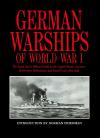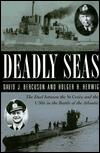German Warships of World War I
The Royal Navy's Official Guide to the Capital Ships, Cruisers, Destroyers, Submarines and Small Craft, 1914-1918
Friedman, Norman and Gardiner, Robert
1992, United States Naval Inst.
ISBN 1557503036
Hardcover, 416 pages
| Type. | Historical document |
| Pros. | Actual Royal Navy intelligence reports of German fleet, numerous sketches and drawings |
| Cons. | None to speak of |
| Rating. |  |
 In every war, the issue of understanding what one's adversary is trying to
do is of critical importance. This certainly was the case during World War
I, as the Royal Navy attempted to determine the goals and tactics of the
German fleet it faced across the North Sea and English Channel. To give its
line officers an in-depth understanding of the powerful German fleet, with
its battleships, battlecruisers, and U-boats, the Royal Navy issued and
updated a series of Confidential Books. These work's final editions have
been combined by publishers Lionel Leventhal and Naval Institute Press into
a single volume called German Warships of World War I: The Royal Navy's
Official Guide to the Capital Ships, Cruisers, Destroyers, Submarines, and
Small Craft, 1914-1918.
In every war, the issue of understanding what one's adversary is trying to
do is of critical importance. This certainly was the case during World War
I, as the Royal Navy attempted to determine the goals and tactics of the
German fleet it faced across the North Sea and English Channel. To give its
line officers an in-depth understanding of the powerful German fleet, with
its battleships, battlecruisers, and U-boats, the Royal Navy issued and
updated a series of Confidential Books. These work's final editions have
been combined by publishers Lionel Leventhal and Naval Institute Press into
a single volume called German Warships of World War I: The Royal Navy's
Official Guide to the Capital Ships, Cruisers, Destroyers, Submarines, and
Small Craft, 1914-1918.
The concept behind the Confidential Books was simple enough: provide an up-to-date intelligence analysis of the German navy. To do this, the work was produced in a series of thick pamphlets or small books, each book covering a different type of ship (capital ships, cruisers, destroyers, submarines, small craft). As needed, each edition on a particular type of ship was superceded by a newer, and presumably more accurate, version as additional information became available. The portion on capital ships dates to October 1918, while the section on submarines is from April 1918, and that on small craft is current only to July 1917.
The natural comparison point for German Warships of World War I would be the contemporaneous issues of Jane's Fighting Ships. The style of presentation and information included in both works is similar, with a great deal of attention placed on the nuances of armor distribution, and certain engineering details though German Warships of World War I goes into greater detail in many cases. Both works also contain silhouettes and line drawings showing arcs of fire. To avoid possibly divulging the site and date of photographs taken of German warships, the Royal Navy hired Dr. Oscar Parkes to produce large scale sketches for the Confidential Books, which are also included in German Warships of World War I. Parkes, aside from being a leading authority on warships in his own right and a future editor of Jane's Fighting Ships, was obviously an artist of some talent, for the drawings are spectacular.
Were this all there were to this book, it would be a useful, though hardly monumental, work. Where it really shines though is in its coverage of U-boats; 128 of the 416 pages are dedicated to German submarines. Included are detailed drawings of the U-57 and U-66 classes as well as types UCI, UCII and UBII. A wealth of technical engineering data is included along with a very interesting description of U-boat tactics. The greater detail in the U-boat section should hardly be surprising; the Royal Navy had no lack of captured and/or sunken U-boats to examine, which certainly was not true of other types of German warships. Unlike the rest of the Confidential Books, the volume on German submarines uses photographs rather than sketches.
The other great insight this book provides is to the depth and accuracy of Allied knowledge of the German navy in World War I and beyond. As Norman Friedman notes in the introduction, this volume represents what the Allies knew of German ship design and operations. They would learn little more before World War II; though after the Armistice they obtained German ships, they did not receive plans or interview those who designed, built, and fought the Kaiser's ships. Certainly, there are cases where the Royal Navy got things very right in its Confidential Books, including many details on U-boats and the rearming of various light cruisers and destroyers. The information obtained about the number and characteristics of ships under construction, however, was much less accurate. The Royal Navy, for example, believed the battlecruiser Mackensen was complete in 1918 when in fact work had been halted on her. Work on three light cruisers, however, was not noted while the design and construction of super destroyers - destroyers armed with a cruiser-sized main gun armament - was completely missed. And even more obviously, the large and expensive E and Cavendish/Improved Birmingham cruiser classes were both built in response to supposed German construction that never actually took place.
This book is a valuable addition to any World War I naval collection. Its full value, however, can only be obtained by comparing it with postwar reference works such as Conway's All The World's Fighting Ships. Still, for those willing to compare and dig, there is much here.
Review written by Michael Lowrey.
Published on 22 Apr 2001.
This title is highly recommended.
Purchase information: (info) Get German Warships of World War I now at amazon.co.uk
Get German Warships of World War I now at amazon.co.uk
Return to our main review page.



